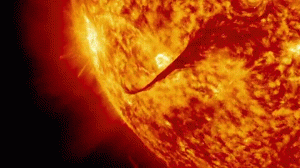
(continued from part 2)
FWHM
At the FWHM, or the 42.5%T point: The bandpass is measured in a single system at 0.7A. In DS system the bandpass is the multiplication of the 2 interference filters, 0.7A x 0.7A = 0.49A. To be specific: The new width of the Etalon T curve is moved by a multiple of the %T at a given point. If the FWHM was 0.7 Angstroms at 42.5%T, the new 0.7 Angstrom bandwidth has been moved down to (42.5% x 42.5% = 18% point)). The 1.2 Angstrom bandpass at the 2%T points are now at the 2% x 2% point = 0.04%. A VERY significant reduction in unwanted transmission at the base of the transmission curve has occurred. This CANNOT be done with ONE Etalon.
The DS transmission curve has become notably narrower at the FWHM, but more importantly, it has become significantly narrower at the base. This has a much more significant impact on the contrast and details than what may be implied by the 0.7A to 0.5A specification.
The h-alpha emission line is approx. 1 Angstrom wide. A Single Stack system is narrow enough to resolve the features contained within this line. It will display Prominences, Spicules, Filaments, Fibrils, and Flares. Edge details are particularly well resolved at 0.7A due to the higher transmission (when compared to DS) and the ability to contrast against the dark background.
I like to think of this as “looking at the details.”
Narrowing of the bandpass
The DS system provides a narrower slice of the details. The narrowing of the bandpass increased the contrast and “pops” the details. With the added ability to Doppler shift (explained in Tuning) from one wing of the h-alpha line to the other (red to blue), you can dissect the fine details.
I like to think of this as “looking into the details.” The larger the scope, the more “into” the details you can get via the higher magnification.
Back when Lunt first began the only way to DS a system was to add an expensive Etalon filter to the front of the Telescope. Large Etalons are challenging to make and priced accordingly. In some cases, the front filter was as much as the dedicated Solar Scope… However, the results were awe-inspiring.
Technology now allows for the DS to be placed internally to the Solar Telescope. By placing the DS system in a smaller part of the optical path we can use a smaller Etalon. This reduction in the size of the Etalon significantly decreases the cost of the secondary DS system. This is true even when you take into account the added pressure tuning, mechanics and optics.
The addition of the internal Etalon has all the advantages of the front mounted version as far as narrowing of the bandpass is concerned.
Drawback
The drawback to an internal DS system is the slight “glow” that the back reflections of the 2 Etalons have. Generally speaking, this glow can be seen when viewing full disk (low magnification) images. However, it is generally not noticeable at higher magnifications, especially when observing the surface details. This glow can be reduced via the use of an additional filter in the system (optional accessory) should full disk imaging be a requirement.
It is generally agreed that the increase in resolution and significant increase in fine detail more than make up for the slight glow at low magnification.
It should be noted that the DS system is easily removed and re-installed into the Solar Telescope.
When choosing a Solar Telescope system, I often advise people to get a Double Stack. If the choice came down to a 100mm Single Stack system vs. an 80mm Double Stack system, I would advise the 80mm DS. They cost about the same, but the cost of adding the DS to the 100mm later is significant.
However, I would take a DS 100m over a DS 80mm any day…
The DS can be added to the Solar Telescope at a later date. The Telescope does not have to be returned to the factory. Double Stack systems are easy to install and remove allowing the user to use the scope at both bandwidths.